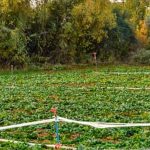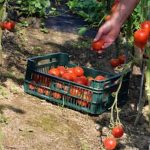New England vegetable gardening 101 provides essential knowledge for cultivating a successful vegetable garden in this region. From understanding the climate to selecting the right vegetables and preparing the soil, this guide will help you navigate the unique challenges and opportunities of gardening in New England.
The New England climate is characterized by cold winters, short summers, and unpredictable weather patterns, making it important to choose vegetables that can thrive in these conditions. With a focus on selecting cold-hardy and short-season varieties, you can optimize your garden’s potential for a bountiful harvest.
In addition to choosing the right vegetables, proper soil preparation is crucial for successful vegetable gardening in New England. By enriching your soil with compost, testing its pH levels, and ensuring good drainage, you can create an optimal growing environment for your plants. In the following sections, we will delve deeper into planting techniques, maintenance tips, pest management strategies, and harvesting practices specific to vegetable gardening in New England to help you achieve a thriving garden.
Understanding the New England Climate and Its Impact on Vegetable Gardening
The climate in New England plays a crucial role in determining the success of your vegetable garden. Understanding the unique weather patterns and conditions in this region can help you make informed decisions when planning and caring for your plants. Here are some key points to consider when it comes to the New England climate and its impact on vegetable gardening:
- New England experiences four distinct seasons, with cold winters, warm summers, and moderate spring and fall seasons.
- The region also receives ample rainfall throughout the year, which can be beneficial for vegetable growth but may also lead to issues such as waterlogging.
- Frost dates in New England vary depending on your specific location, so it’s essential to know when the last frost typically occurs in spring and when the first frost is expected in fall.
In addition to these general climate characteristics, New England is known for its microclimates. Factors such as proximity to bodies of water, elevation, and urban versus rural environments can all influence local weather conditions. When planning your vegetable garden, take these factors into account to ensure that your plants receive the appropriate amount of sunlight, moisture, and protection from harsh winds.
Considering the challenges posed by New England’s climate, selecting resilient vegetable varieties that are well-suited to the region is key. Opt for cold-hardy crops that can withstand fluctuations in temperature and are less susceptible to common pests and diseases.
Some vegetables that thrive in New England include broccoli, kale, carrots, lettuce, peas, and potatoes. By choosing the right plants for your garden, you can maximize your chances of a successful harvest despite the sometimes unpredictable weather conditions in this region.
Selecting the Right Vegetables for New England’s Unique Growing Conditions
When it comes to successful vegetable gardening in New England, selecting the right vegetables that can thrive in the region’s unique growing conditions is crucial. From the cool springs to the hot summers and frosty winters, New England has a varied climate that can present challenges to gardeners. However, with careful selection of vegetables that are well-suited to these conditions, you can still enjoy a bountiful harvest.
To help you make informed choices for your New England vegetable garden, here are some vegetables that are known to perform well in this region:
- Tomatoes: Choose varieties like “Celebrity,” “Early Girl,” or “Big Beef” that have a shorter growing season and can withstand fluctuations in temperature.
- Squash: Varieties like zucchini, butternut squash, and acorn squash thrive in the warm summers of New England.
- Leafy greens: Vegetables like lettuce, spinach, and kale are great choices for early spring and fall planting when temperatures are cooler.
It’s important to consider not only the climate but also factors like soil quality and sunlight exposure when selecting vegetables for your garden. By choosing vegetables that are well-suited to New England’s conditions, you’ll set yourself up for a successful growing season. With attention to detail and proper care, you can enjoy a thriving vegetable garden filled with fresh produce throughout the year.
So whether you’re a seasoned gardener or just starting out with your new england vegetable gardening 101 journey, taking the time to select the right vegetables for your specific location will go a long way in ensuring a fruitful harvest. Don’t be afraid to experiment with different varieties and observe which ones work best in your garden – after all, gardening is as much an art as it is a science.
Preparing Your Soil for Optimal Vegetable Growth in New England
When it comes to successful New England vegetable gardening, one of the most critical steps is preparing your soil for optimal growth. The region’s unique climate and soil conditions can pose challenges, but with the right approach, you can create a fertile ground that will nourish your plants throughout the growing season. Soil preparation involves a combination of testing, amending, and proper care to ensure that your vegetables thrive.
To start with, it’s essential to test your soil to understand its composition and nutrient levels. You can obtain a soil test kit from your local Cooperative Extension office or garden center. The results will help you determine if any amendments are needed to improve the soil quality. In New England, many soils tend to be acidic, so adding lime may be necessary to achieve the proper pH level for optimal plant growth.
In addition to addressing pH levels, organic matter is crucial for healthy soil in New England vegetable gardens. Compost or well-rotted manure can be added to improve soil structure and provide essential nutrients for plant growth.
Incorporating organic matter into your soil not only enhances its fertility but also helps with moisture retention and drainage. By taking the time to prepare your soil correctly at the beginning of the gardening season, you can set a strong foundation for abundant harvests later on.
| Soil Preparation Steps | Benefits |
|---|---|
| Test your soil for pH levels and nutrient content | Optimizes plant growth by providing essential nutrients |
| Add lime or other amendments as needed | Balances pH levels for healthy plant development |
| Incorporate compost or manure into the soil | Improves soil structure, fertility, moisture retention & drainage |
Tips for Planting and Spacing Your Vegetable Garden in New England
Planting and spacing your vegetable garden correctly is crucial for a successful harvest in New England. One key aspect to consider is the timing of planting. Due to the region’s cooler climate, it is important to start planting certain vegetables after the last frost date.
For example, warm-season crops like tomatoes, peppers, and eggplants should be planted in late spring when the soil has warmed up sufficiently. On the other hand, cool-season crops like lettuce, broccoli, and carrots can be planted earlier in the season.
When it comes to spacing your vegetable garden in New England, following proper guidelines will help maximize growth and yield. Each type of vegetable has specific spacing requirements based on its size and root system. For example, larger plants like tomatoes or squash need more space between them to prevent overcrowding and competition for nutrients. It is also important to consider vertical spacing for vining plants like cucumbers or pole beans by providing adequate support structures.
Properly spaced plants not only promote healthier growth but also reduce the risk of diseases that can spread easily in crowded conditions. Adequate air circulation between plants helps prevent moisture buildup and fungal infections. Additionally, spacing plants appropriately allows for easier access for watering, weeding, and harvesting throughout the growing season. By following these tips for planting and spacing your vegetable garden in New England, you can set yourself up for a bountiful harvest of fresh produce.
| Vegetable Type | Spacing Requirements |
|---|---|
| Tomatoes | 18-24 inches apart |
| Lettuce | 6-12 inches apart |
| Zucchini | 24-36 inches apart |
Maintaining Your Vegetable Garden Through the Changing Seasons in New England
Spring Care
As the winter frost thaws and the days grow longer, it’s time to start preparing your vegetable garden for the growing season ahead. In New England, spring is a crucial time for tending to your garden beds.
Begin by cleaning up any debris left over from the winter months, removing weeds, and checking for any signs of damage. It’s also a good time to amend your soil with compost or organic matter to provide essential nutrients for your vegetables.
Summer Maintenance
Once summer arrives in New England, your vegetable garden will be in full swing. Regular watering is essential during this time, as the hot sun can quickly dry out the soil. Be sure to water deeply to encourage strong root growth and prevent shallow-rooted plants.
Stay vigilant against pests and diseases that thrive in the warm weather by keeping a close eye on your plants and addressing any issues promptly. Consider mulching around your vegetables to help retain moisture and suppress weeds.
Fall Preparation
As fall approaches in New England, it’s time to start thinking about preparing your vegetable garden for the colder months ahead. Harvest any remaining crops before the first frost hits and consider planting cold-hardy vegetables like kale, carrots, and Brussels sprouts for a late-season harvest.
Fall is also an excellent time to clean up your garden beds, remove spent plants, and add a layer of mulch or compost to protect the soil during the winter months. By taking these steps, you can set yourself up for success come springtime when it’s time to start anew in your New England vegetable garden.
Incorporating these seasonal maintenance tips into your routine will help ensure that you have a thriving vegetable garden throughout the changing seasons in New England. With proper care and attention, you can enjoy a bountiful harvest year after year from your own backyard oasis of fresh produce.
Dealing With Common Pests and Diseases in New England Vegetable Gardens
Pests and diseases can easily wreak havoc on your New England vegetable garden if left unchecked. However, with proper knowledge and proactive measures, you can effectively deal with these challenges and protect your precious crops.
Identifying Common Pests
One of the first steps in pest management is being able to identify the culprits. In New England, common pests that plague vegetable gardens include aphids, cabbage worms, squash bugs, and tomato hornworms. These pests can quickly multiply and cause significant damage to your plants if not addressed promptly.
Implementing Natural Pest Control Methods
To maintain a healthy balance in your vegetable garden ecosystem, consider implementing natural pest control methods. This can include introducing beneficial insects like ladybugs and praying mantises to prey on harmful pests. Additionally, planting companion plants that repel pests or using organic insecticidal soaps can help keep pest populations in check without harming the environment or beneficial insects.
Fighting Diseases
Diseases like powdery mildew, blight, and root rot can also pose a threat to your vegetable garden in New England. To prevent the spread of diseases, practice good sanitation by removing any infected plant material promptly. Utilize crop rotation techniques to reduce the buildup of disease-causing pathogens in the soil.
Consider using disease-resistant varieties of vegetables to minimize the risk of infection in your garden. Monitoring your plants regularly for any signs of disease and acting swiftly can help prevent loss of crops due to diseases. By staying vigilant and taking proactive measures, you can effectively manage common pests and diseases in your New England vegetable garden while ensuring a bountiful harvest.
Harvesting and Enjoying the Fruits of Your Labor
As you reach the rewarding stage of harvesting your freshly grown produce in your New England vegetable garden, it’s essential to maximize your yields and enjoy the fruits of your labor. By following the practices and tips outlined throughout this guide, you have set a strong foundation for a successful harvest.
To ensure a bountiful harvest, it is crucial to stay attentive to the needs of your plants. Regularly monitor their growth, water them adequately, keep weeds at bay, and consider using organic fertilizers to provide essential nutrients. Additionally, proper spacing between plants can help optimize sunlight and airflow, reducing the risk of diseases that can hinder productivity.
When it comes time to harvest your vegetables, make sure to pick them at their peak ripeness for the best flavor and nutritional value. Engage in sustainable harvesting practices by only picking what you need and allowing others to fully mature for later picking. Remember that some vegetables like tomatoes and zucchinis are best harvested regularly to encourage continuous growth throughout the season.
In conclusion, New England vegetable gardening 101 equips you with the knowledge and skills needed to achieve a successful harvest in this unique climate. By understanding the regional climate, selecting appropriate crops, preparing soil effectively, planting strategically, maintaining vigilance against pests and diseases, and implementing smart harvesting techniques-you can savor the joys of cultivating your own fresh produce from seed to plate in your very own backyard oasis. Happy gardening.
Frequently Asked Questions
When Should I Start a Vegetable Garden in New England?
Starting a vegetable garden in New England depends on the specific vegetables you want to grow. Typically, cool-season vegetables like lettuce and spinach can be started as early as March or April, while warm-season vegetables like tomatoes and peppers are usually planted after the last frost date, around late May or early June.
What Vegetables Are Easy to Grow in New England?
There are several vegetables that are relatively easy to grow in New England. Some examples include lettuce, spinach, radishes, beans, cucumbers, zucchini, and peas. These vegetables tend to be hardy and resilient in the region’s climate, making them ideal for beginners.
What Should I Put in My Beginner Vegetable Garden?
For a beginner vegetable garden in New England, it is recommended to start with easy-to-grow crops like lettuce, radishes, and beans. It’s important to consider the space available for your garden and choose vegetables that will thrive in your specific location.
Additionally, make sure to properly prepare the soil by adding compost or other organic matter to improve plant growth. Finally, be mindful of watering and pest control practices to ensure a successful harvest.

If you’re looking to get into vegetable gardening, or are just looking for some tips on how to make your current garden better, then you’ve come to the right place! My name is Ethel and I have been gardening for years. In this blog, I’m going to share with you some of my best tips on how to create a successful vegetable garden.





